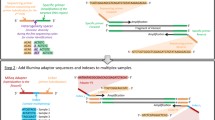Abstract
Unbiased identification of organisms by PCR reactions using universal primers followed by DNA sequencing assumes positive amplification. We used six universal loci spanning 48 plant species and quantified the bias at each step of the identification process from end point PCR to next-generation sequencing. End point amplification was significantly different for single loci and between species. Quantitative PCR revealed that Cq threshold for various loci, even within a single DNA extraction, showed 2,000-fold differences in DNA quantity after amplification. Next-generation sequencing (NGS) experiments in nine species showed significant biases towards species and specific loci using adaptor-specific primers. NGS sequencing bias may be predicted to some extent by the Cq values of qPCR amplification.



Similar content being viewed by others

References
Hajibabaei M, Singer GAC, Hebert PDN, Hickey DA (2007) DNA barcoding: how it complements taxonomy, molecular phylogenetics and population genetics. Trends Genet 23:167–172. doi:10.1016/J.Tig.2007.02.001
Hajibabaei M, Janzen DH, Burns JM et al (2006) DNA barcodes distinguish species of tropical Lepidoptera. Proc Natl Acad Sci U S A 103:968–971
Pawluczyk M, Weiss J, Vicente-Colomer MJ, Egea-Cortines M (2012) Two alleles of rpoB and rpoC1 distinguish an endemic European population from Cistus heterophyllus and its putative hybrid (C. x clausonis) with C. albidus. Plant Syst Evol 298:409–419
Krüger M, Stockinger H, Krüger C et al (2009) DNA-based species level detection of Glomeromycota: one PCR primer set for all arbuscular mycorrhizal fungi. New Phytol 183:212–223. doi:10.1111/j.1469-8137.2009.02835.x
Links MG, Dumonceaux TJ, Hemmingsen SM, Hill JE (2012) The chaperonin-60 universal target is a barcode for bacteria that enables de novo assembly of metagenomic sequence data. PLoS ONE 7:e49755. doi:10.1371/journal.pone.0049755
Hollingsworth PM, Forrest LL, Spouge JL et al (2009) A DNA barcode for land plants. Proc Natl Acad Sci U S A 106:12794–12797. doi:10.1073/Pnas.0905845106
Kress WJ, Erickson DL (2007) A two-locus global DNA barcode for land plants: the coding rbcL gene complements the non-coding trnH-psbA spacer region. PLoS ONE 2:e508. doi:10.1371/journal.pone.0000508
Links MG, Chaban B, Hemmingsen SM et al (2013) mPUMA: a computational approach to microbiota analysis by de novo assembly of operational taxonomic units based on protein-coding barcode sequences. Microbiome 1:23. doi:10.1186/2049-2618-1-23
Coissac E, Riaz T, Puillandre N (2012) Bioinformatic challenges for DNA metabarcoding of plants and animals. Mol Ecol 21:1834–1847. doi:10.1111/j.1365-294X.2012.05550.x
Amend AS, Seifert KA, Bruns TD (2010) Quantifying microbial communities with 454 pyrosequencing: does read abundance count? Mol Ecol 19:5555–5565. doi:10.1111/j.1365-294X.2010.04898.x
Links MG, Demeke T, Gräfenhan T et al (2014) Simultaneous profiling of seed-associated bacteria and fungi reveals antagonistic interactions between microorganisms within a shared epiphytic microbiome on Triticum and Brassica seeds. New Phytol. doi:10.1111/nph.12693
Platts AE, Johnson GD, Linnemann AK, Krawetz SA (2008) Real-time PCR quantification using a variable reaction efficiency model. Anal Biochem 380:315–322
Pfaffl MW, Horgan GW, Dempfle L (2002) Relative expression software tool (REST(C)) for group-wise comparison and statistical analysis of relative expression results in real-time PCR. Nucleic Acids Res 30:e36. doi:10.1093/nar/30.9.e36
Mallona I, Weiss J, Egea-Cortines M (2011) pcrEfficiency: a Web tool for PCR amplification efficiency prediction. BMC Bioinforma 12:404. doi:10.1186/1471-2105-12-404
D’haene B, Vandesompele J, Hellemans J (2010) Accurate and objective copy number profiling using real-time quantitative PCR. Methods 50:262–270. doi:10.1016/j.ymeth.2009.12.007
Von Holst C, Boix A, Marien A, Prado M (2012) Factors influencing the accuracy of measurements with real-time PCR: the example of the determination of processed animal proteins. Food Control 24:142–147. doi:10.1016/j.foodcont.2011.09.017
Bustin SA, Benes V, Garson JA et al (2009) The MIQE guidelines: minimum information for publication of quantitative real-time PCR experiments. Clin Chem 55:611–622. doi:10.1373/clinchem.2008.112797
Schmittgen TD, Livak KJ (2008) Analyzing real-time PCR data by the comparative CT method. Nat Protoc 3:1101–1108. doi:10.1038/nprot.2008.73
Mardis ER (2008) The impact of next-generation sequencing technology on genetics. Trends Genet 24:133–141. doi:10.1016/j.tig.2007.12.007
Ritz C, Spiess AN (2008) qpcR: an R package for sigmoidal model selection in quantitative real-time polymerase chain reaction analysis. Bioinformatics 24:1549–1551. doi:10.1093/Bioinformatics/Btn227
Spiess A-N, Feig C, Ritz C (2008) Highly accurate sigmoidal fitting of real-time PCR data by introducing a parameter for asymmetry. BMC Bioinforma 9:221. doi:10.1186/1471-2105-9-221
Polz MF, Cavanaugh CM (1998) Bias in template-to-product ratios in multitemplate PCR. Appl Environ Microbiol 64:3724–3730
Suzuki M, Giovannoni S (1996) Bias caused by template annealing in the amplification of mixtures of 16S rRNA genes by PCR. Appl Environ Microbiol 62:625–630
Benita Y, Oosting RS, Lok MC, et al. (2003) Regionalized GC content of template DNA as a predictor of PCR success. 31:1–7. doi: 10.1093/nar/gng101
Acknowledgments
This work was performed as partial fulfillment of the PhD of Marta Pawluczyk. This work was funded by the Comunidad Autónoma de la Región de Murcia Project “Molecular markers in conservation and management of the flora of Murcia Region” (“Marcadores moleculares en conservación y gestión de la flora murciana”). Part of the work was performed under the Proyecto Vitalis Campus Mare Nostrum “Espacio Mediterráneo de Investigación en Red en Alimentos y Salud” - CEI10-2-0002.
Data availability
Raw and processed data will be made publicly available via entries in Data Dryad, and a formal Data Descriptor will be published detailing the methodologies and workflows used, as well as rich descriptions of the data elements themselves. The analytical workflow for sequence processing and mapping is already publicly available as a Galaxy workflow, as described in the manuscript, and can be freely re-run at any time. The analysis can be reproduced, with the same parameters and data, at the following Galaxy installation (page: http://biordf.org:8983/u/mikel-egana-aranguren/p/sources-of-bias-in-applying-barcoding-markers-for-sequence-analysis-of-environmental-samples).
Author information
Authors and Affiliations
Corresponding author
Rights and permissions
About this article
Cite this article
Pawluczyk, M., Weiss, J., Links, M.G. et al. Quantitative evaluation of bias in PCR amplification and next-generation sequencing derived from metabarcoding samples. Anal Bioanal Chem 407, 1841–1848 (2015). https://doi.org/10.1007/s00216-014-8435-y
Received:
Revised:
Accepted:
Published:
Issue Date:
DOI: https://doi.org/10.1007/s00216-014-8435-y



